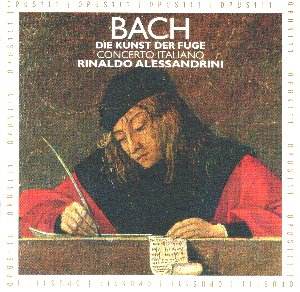Johann Sebastian BACH (1685 -1750) 74'27"
Die Kunst der Fuge (The Art of Fugue)
 Concerto
Italiano Rinaldo Alessandrini (director)
Concerto
Italiano Rinaldo Alessandrini (director)
 Recorded Frascati, Italy.
June 1998 DDD Opus 111 OPS 30 - 191
Recorded Frascati, Italy.
June 1998 DDD Opus 111 OPS 30 - 191
Crotchet
There is what appears to be a mid-price reissue
of this recording
Crotchet

Bach's "Die Kunst der Fuge", better known in English as "the Art of Fugue"
is one of western music's great imponderables. The story briefly is this.
Bach was a member, along with mathematicians and composers who included Handel
and Telemann, of a Society "For the furtherance of Musical Science". One
condition of membership was that members had to present a paper or a composition
with a scientific content each year.
The great man died in 1750, and left unfinished a work that was likely to
have been his submission to the Society for 1749. His son, C.P.E.Bach, after
his father's death made clear that the penultimate section ( a fugue on B,A,C,H,
) had not been finished, but publication would go ahead and it would incorporate
a closing chorale completed by family and friends.
As published the work has 24 sections (including the incorporated chorale).
Ever since publication the work has been a musicologist's delight and is
still 250 years later as enigmatic as it ever was. The puzzle is two-fold.
Firstly, was the work meant to be performed, or was it simply to be a mental
visualisation of the written score and its complex counterpoint? Or, if it
were to be played - on what combination of instruments? No clues were given
by Bach and generations of musicians have made their own decisions as to
performance and instrumentation in a variety of ways - orchestral, chamber
groups, solo keyboard and so on.
The choice made on this CD by Rinaldo Alessandrini was to use varying
combinations from nine players (giving a choice of twelve instruments) from
his Concerto Italiano - a specialist period music ensemble which uses a
combination of original instruments and modern copies of originals.
The combination of strings, woodwind and harpsichord gave an extra tonal
variety that is sometimes lacking in dry as dust versions of this work. In
Contrapunctus 4 for instance, the blend of flute, oboe d'amore with its
distinctive timbre, bassoon and cello was captivating, swinging even - followed
quickly by the beautifully articulated 1st canon for solo harpsichord. The
excellent recording allowed the ear to revel in the musical cats-cradle of
Section 9 - all the players were used in this one - and every line could
be clearly heard. Section 16, just two players - violin and harpsichord -
again showed imaginative selection. Intriguingly the closing section was
played by a conventional string quartet.
All through, in this esoteric work built on the simplest of structures, the
rhythms are buoyant and with the combination of fine playing, a splendidly
judged instrumental mix and an excellent recording this release must be highly
recommended.
Reviewer
Harry Downey

